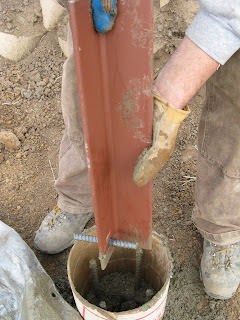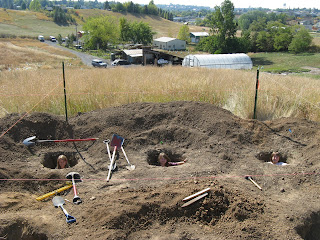This late fall, Peter and I have been hard at work milling the timbers for the studio. We wanted to mill everything before snow prevented easy access to the mill site.
This work is moderately rewarding: It takes a long time to move logs onto the mill and into the correct position. However, the payoff happens when one gets to open up a log and look inside for the first time. Even after milling dozen of timbers, I get a kick out of seeing a near-perfectly square timber take shape out of a curved, knobby, muddy, bark-covered log. The better the wood quality, the more fun it is. Large, clear, straight logs with no obvious pitch pockets are the best. As far as preferred species, Western Larch and American Elm are particularly rewarding, as well as the rare high-quality Douglas Fir log. Clear Ponderosa and Lodgepole Pine is nice too. Heck, its
all good.
Lacking large machinery for moving logs around we often have to rely on levers and cant hooks (aka peaveys) to move logs into position. Here is Peter, standing atop our log deck, rolling a large log off the deck all the way down to the sawmill:

Peter is more cavalier about standing on top of an unstable log deck than I am. :-)

Rolling a log up onto the mill can be challenging. I bought optional spring-loaded ramps which make this a lot easier. The log "rachets" up the ramps. Even working alone, I can move a very heavy log into position on the mill with the aid of a cant hook.

Here, Peter is operating the sawmill, finishing the top cut which will finalize this large timber. Each ripping cut takes a matter of seconds. Most sawing time is spent setting up cuts to make things square. Carefully planning out how to get the most out of each log and then moving things carefully into position really pays off and reduces waste.


The sawmill sounds like a large, loud lawn mower engine. Hearing protection is a great idea.

Here, you can see the back of the bandsaw blade as it makes a cut into the log.

The bandsaw is lubricated with water. You can see that here:

Here I am, finishing a cut on a massive Ponderosa Pine log.

This pine log turned into a huge 13"x14" timber. It had enough defects (knots) to prevent its use as a beam, although it might make an excellent post or it could be cut into 1"x12" boards and used as board and batten siding. A lot of barns around the Palouse use pine board and batten siding. I've seen original, 100 year old pine siding in good shape on some of these barns.

Below, I am milling a large dead-standing Western Larch log. This timber will be one of the three large top plates on the studio. It will be partially responsible for supporting the weight of the heavy living roof. I've always found that Larch seems to check more severely than most other native softwoods. The fact that it was harvested as dead-standing means that it is drier and more stable (i.e. seasoned) than most of our other green logs. It is critical that top plates don't warp too much.




We've finished almost all of the milling for this project, although finding/carving the large curved beam on the front of the studio is proving challenging...




























































